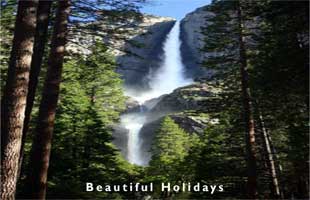Sierra Nevada & Yosemite Guide
USA, North America

The Sierra Nevada Mountain Range is a mountain range that runs 640 km north to south along California and approximately 110 km east to west into Nevada. Right in the heart of the Sierra Nevada Range, you will find the National Parks of Yosemite, Kings Canyon and Sequoia. To the north is Yosemite, near Mariposa, while more to the south is King's Canyon and Sequoia, near Fresno. These parks all feature Sequoia trees, or redwoods, a coniferous tree which only grows on the western slopes of the Sierra Nevadas of California. The largest trees in existence, some of them are known to be over 3 000 years old. These parks also feature plenty of outdoor recreation opportunities as well and are known for the outstanding outdoor scenery.
Yosemite National Park Holiday Planner
Perhaps the busiest of these three parks is Yosemite with an estimated 3.7 million annual visitors. With an estimated 95% of this 761 000 acre park designated as a wilderness area, most of the visitors stick to the section of the park that is open year round, the valley. For more dedicated adventurers however, there are over 1 300 km of trails that range in elevation from 2 100 to 13 000 feet. With a permit and approved bear-proof food containers, you can hike for several days through the park.
Near the entrance to the park is the Yosemite Museum where you can see a history of the natural and cultural origins of the park. You may also choose to drive the scenic Tioga Road to its terminus at Tuolumne Meadows. Although mountain biking is not allowed in the park, you can rent bicycles to ride along the roads. There are also numerous winter activities at the park, such as downhill skiing at Badger Pass and cross country/snow shoeing trails with warming huts that criss-cross the area.
For climbers, there are numerous granite cliffs, including the daunting El Capitan for dedicated enthusiasts. There are numerous waterfalls, canyons, and wildlife for sightseers to view throughout the park as well.
Kings Canyon and Sequoia National Parks are adjacent to each other, yet separate. Kings Canyon is so named for the confluence of the Kings River and the south fork of the San Joaquin River which leads to a canyon that is 8 200 feet deep. This granite canyon was carved by glaciers, and so was neighbouring Tehipite Valley. The highest peak is the 4 300 foot North Palisade, and Boyden Cave is open to the public for viewing. This is classic High Sierra country with its barren alpine ridges, glacial features and lake filled basins.
Sequoia National Park has five of the world's largest trees in its borders. The world's largest tree, the Giant Sequoia, General Sherman, is also located here. The park is joined to Kings Canyon National Park by the Generals Highway. The wildlife of the area is varied, including bobcats, foxes, ground squirrels, mule deer, and rattlesnakes. The park grounds used to be home to the Monachee group of Native Americans, and pictographs can still be viewed at Hospital Rock and Potwisha. By the time settlers arrived, the Monachee had been devastated by smallpox. Settlers tried logging the Sequoias but ceased when it was discovered that the lumber easily splintered and was of little use, to the delight of early conservationists bent on preserving the area for its natural beauty.
This area of the Sierra Nevadas is full of caves, including California's longest cave at over 20 miles long, the Lilburn Cave. There are over 200 caves, with many still being discovered to this day, but most have access limited to scientists. For public access, there are guided tours of Crystal Cave.



